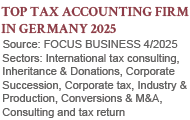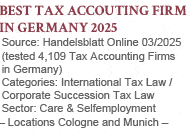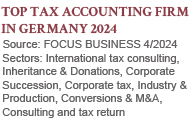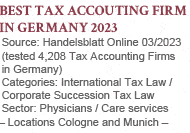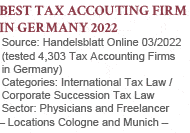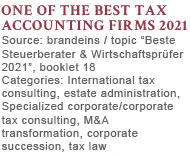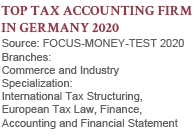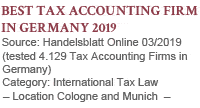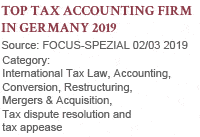

BMF Administrative Principles 2020
Transfer Prices/Transfer Pricing
By Dr. Peter Happe
Dated December 3, 2020, the Federal Ministry of Finance issued a new coordinating state decree entitled “Administrative Principles 2020”.
The Administrative Principles 2020 specify and supplement the statutory provisions as well as the Profit Allocation Recording Ordinance – GaufZ of July 12, 2017 or the auxiliary and secondary calculations to be prepared according to the Permanent Establishment Profit Allocation Ordinance – BSGaV of October 13, 2014. In particular, the Administrative Principles 2020 supplement and amend in Tz. 91 in certain points the BMF letter of April 12, 2005, the so-called Administrative Principles-Procedures, in which the transfer pricing methods are treated.
The Administrative Principles 2020 regulate the obligations to cooperate of the taxpayers, especially in foreign matters, and the power of estimation of the tax administration in the cases in which the taxpayer does not fulfill his obligations to cooperate.
The letter is divided into two main parts. The first main part deals with the taxpayer’s obligations to cooperate; the second main part deals with the estimations and surcharges if the taxpayer does not comply with his statutory obligations to cooperate.
The first main part is in turn divided into three sections and is thus based on § 90 AO. The first section deals with the general obligations to cooperate of the taxpayers in accordance with § 90 para. 1 AO. According to this, the principle applies that the official investigation obligation and the obligation to cooperate in the investigation of the facts exist side by side. There is generally no right to refuse cooperation for participants. If an authorized representative is appointed, the tax authority should contact him for clarification.
The second section regulates the obligations to cooperate for foreign matters within the meaning of § 90 para. 2 AO. Here, increased obligations to cooperate and clarify apply. For the purpose of preserving evidence, the participant must comprehensively retain and surrender all records, documents and data of a foreign related party within the scope of its legal and factual possibilities. These documents may not be destroyed before the expiry of the domestic retention periods. This also includes documents and data of the related party that allow the tax administration to verify the transfer pricing methods and transfer prices. According to the tax administration, a participant can hardly claim that he cannot legally and factually submit the evidence because only a related party has it. According to the German tax administration, it is reasonable, for example, for the German participant to keep information on the sales price of the related foreign distribution company, calculation documents for the cost-plus method, contributions of the cooperating companies in the cost allocation agreement, evidence of sales generated by the licensee in the case of sales-dependent license fees or documents on the allocation key when applying the transaction-related profit split method from abroad, because a merchant would also have the transfer of such information contractually assured by third parties.
The third section regulates the documentation of intra-group transactions according to § 90 para. 3 AO. According to this, taxpayers must prepare a transfer pricing documentation consisting of a factual documentation, a documentation of the transfer pricing methods applied for so-called transfer prices and an so-called appropriateness documentation in accordance with international practice. Taxpaying companies that are part of a multinational group of companies must also provide in the records an overview of the worldwide business activity and the applied transfer pricing system if they generate a turnover of EUR 100 million or more. As a rule, the transfer pricing documentation is only to be kept ready for external audits and to be submitted to the tax administration within a period of 60 days upon request. Records of extraordinary business transactions must be prepared promptly and submitted within 30 days of being requested by the tax administration. The records according to § 90 para. 3 AO must prove the taxpayer’s serious effort to design its business relations with foreign countries in compliance with the arm’s length principle.
The factual documentation should provide the following information using the example of sales:
| Activity | Functions | Assets Used | Risks |
| Sales | Warehousing, advertising, sales, financing, transport, customs clearance, assembly, technical support, customer service, pricing | Distribution law, trademark law, customer base, vehicles, storage device | Sales risk (change in public taste, economic weakness), chance of a net profit from trading or sales activities, market price risk, collection risk |
The records must provide an expert third party with a basic understanding of the value creation in the group of companies or in a uniform company of the business model and the function and risk profile of the transaction partners in a reasonable time. The functions handled with the individual related parties are to present an overview with regard to their type and the amount of the remuneration (so-called transaction overview).
The appropriateness documentation must document the serious effort that the arm’s length principle resulting from the economic and legal bases was correctly applied for the tax determination of income. The tax administration can question and verify the transfer pricing method used. The relevant point in time for the arm’s length comparison is generally the conclusion of the contract, if a contract was concluded, not the time of performance. The taxpayer can rely on arm’s length comparison data that became known subsequently. Also, planned data can possibly be used as a basis if they refer to already expired periods and on the basis of commercial, business management-based, cautious forecasts.
In addition, a master documentation must be prepared, which is also referred to as a master file, if the turnover limit of EUR 100 million is exceeded. Details can be found in §5 para. 2 Profit Allocation Recording Ordinance.
In the second main part of the Administrative Principles 2020, estimations and surcharges according to § 162 AO are finally treated, which affect the taxpayer as a so-called “spoiler of evidence” with the intention of skimming off the advantage from a lack of cooperation. For this purpose, the tax office may estimate. The basis of the estimation is to assume in an act of evaluating reasoning from the facts that comes closest to reality. The estimation results must be conclusive, economically possible and reasonable. Database studies are a permissible estimation method within the meaning of § 162 AO. For an income adjustment, defects in the justification of the appropriateness of transfer prices alone are not sufficient, but rather the transfer prices applied by the taxpayer must with a high probability not correspond to the arm’s length comparison and the transfer price determined by the tax authority must at least be more likely. If the authority estimates deliberately arbitrarily and to the detriment of the taxpayer, this can lead to the nullity of the estimation notice. In transfer pricing cases, an estimation according to § 162 AO should lead to taxation of the profit that would have been achieved if arm’s length prices had been applied.
The tax office can exhaust a range of estimated values to the detriment of the taxpayer.
If (a) the submitted records are essentially unusable or no records are submitted or (b) usable records for extraordinary business transactions have not been prepared promptly, a surcharge can also be imposed in addition to an estimation. The surcharge amounts to EUR 5,000; however, it should be at least 5%, but not more than 10% of the additional amount of income if an estimation had to be carried out. In the event of late submission of usable records, the surcharge amounts to up to EUR 1 million, but at least EUR 100 for each full day of exceeding the deadline.





